Chernobyl Red forest
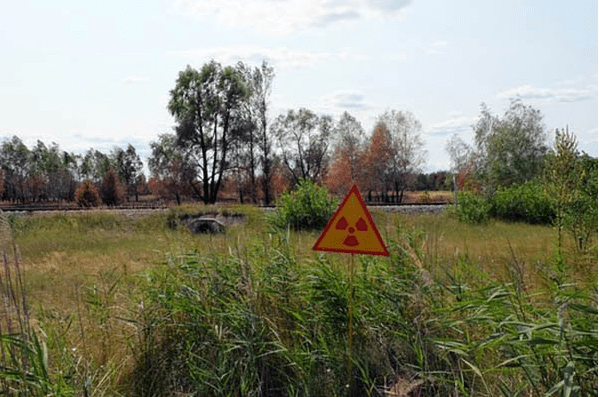
As a consequence of the Chernobyl disaster about 10 km² of forest, located to the west of the station in the close proximity of the Chernobyl nuclear power plant were heavily contaminated. These were mainly monocultural plantations of Scot pine. Indications of radioactive damage to coniferous trees were already manifested at absorbed doses of about 10,000 Chernobyl Red Forest radiation levels. In the region of the maximum radiation, where the calculated accumulated dose of radiation reached 8,000 – 10,000rad, pine plantations died entirely within a few days. Their needles turned reddish-brown thus named a “Red Forest”.
- Chernobyl Red Forest location
- History of the Chernobyl Red Forest
- Facts about great Chernobyl fire in Red Forest 2015
- Chernobyl Red Forest radiation levels
- Chernobyl Red forest today
The dead forest posed a significant hazard, such as fire, as a source of secondary radioactive contamination. In 1987 burial of the dead trees and the upper layer of soil was performed by felling, raking and laying in the trench, followed by backfilling with a layer of soil about 1 meter thick. Altogether, more than 4,000 cubic meters of radioactive materials were buried. Owing to these measures, the exposure dose rate of gamma radiation decreased 4-50 times and in the second half of 1987 (after decontamination work) the max dose rates were 180 mR/h.
Over time, pines and other plants have recovered naturally and have been studied by many botanists. Evacuation of people and cessation of economic activity had a positive factor that outweighs the impact of radiation, namely increasing of Chernobyl Red Forest wildlife, as well as rare species of animals that are listed in the Red Book began to appear over time. The abandoned exclusion zone of Chernobyl Red Forest today has become a real natural reserve. There live bears and bison, wolves and lynxes, wild boars and Przewalski’s horses, and many other animals, not counting a couple of hundred species of birds.
Chernobyl Red Forest location
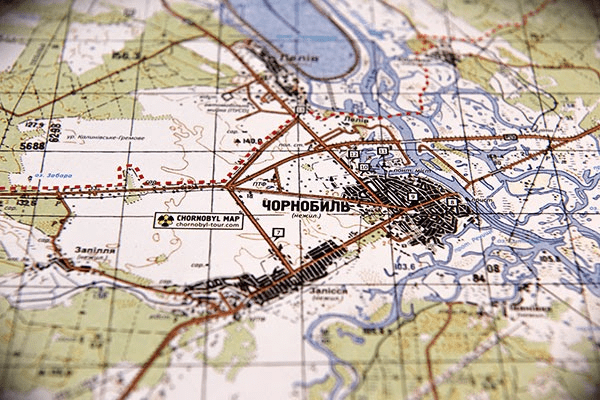
The Chernobyl Exclusion Zone is located on the territory of Ukraine in a closed regime territory. The distance to Kiev is 111 km. An access to the territory of the Zone is allowed only to employees ̶ by special passes, or to visitors to the Zone ̶ by pre-planned tours with the correspondent passes. Town of Pripyat is separated from the Chernobyl nuclear power plant by only 3 km and the ChernobylRed Forest. At present, visits to Pripyat are only allowed as part of organised tour groups, with passes ordered and strict itineraries. But one can find both one-day tours and longer ones (up to a week).
History of the Chernobyl Red Forest
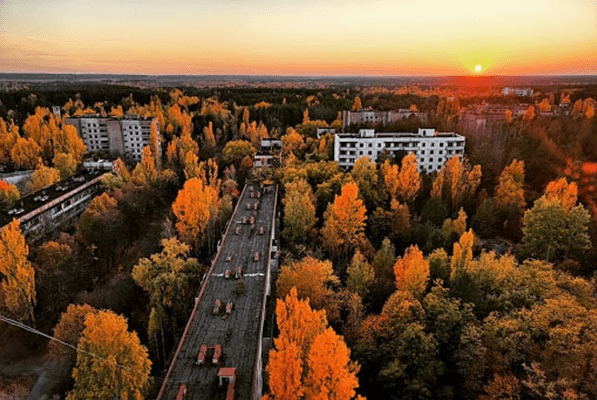
In order to get acquainted with the current state of the Red Forest, you need to delve a little into its not very pleasant story. The Red Forest is located 2 kilometers from the Chernobyl nuclear power plant, it was this close proximity to the epicenter of the sad events of 1986 that played a cruel joke with him. After the accident at the station and the result of an atomic fire explosion, gigantic emissions of radioactive dust with the help of the outbursts of wind covered a nearby forest belt. It was this dust that instantly destroyed the trees: the pines simply burned out from the highest level of radiation and dramatically changed the color from green to an unusual reddish shade for them. In addition to the fact that the dead needles became very dangerous, she began irreversible processes of destruction of the ecosystem around her. In order to avoid even greater disaster, it was decided to demolish and bury the forest.
During the burial process, workers mainly used special engineering barrage machines and bulldozers. However, in archival photographs you can see how the liquidators manually cut the trees with chainsaws, and from overalls they put on an ordinary chimza and a one-time dressing. One can only guess what consequences pulled such a negligent attitude towards the safety of workers. Negligence manifested itself in another aspect related to the burial of the forest: the depth of the trenches into which the felled trees were thrown down was only 1.5-2 meters. It is at this depth that groundwater deposits are located, that is, an illiterate calculated burial depth led to the ingress of hazardous radionuclides into the basins of Pripyat and the Dnieper. The forest decontamination procedure did not help eliminate or minimize environmental problems; on the contrary, it only aggravated them.
Nowadays, the forest is gradually being restored naturally. Deciduous plantations develop on the site of pine trees, due to perennial grasses, a slow sodding of the soil occurs, gradually its indigenous inhabitants return to the forest. But there are some changes – certain types of trees, as a result of a high level of radiation, underwent metamorphoses: for example, in pine trees, the shape and length of the needles was deformed, and their number increased. Thirty years ago, not only amazing natural corners, but also the status of PVLRO assigned to the territory, a point of temporary localization of radioactive waste with a high level of pollution, remind of the sad disaster of thirty years ago.
And yet, in conclusion, we must pay tribute to the Red Forest. At the cost of his life, the forest, like a filter, detained tons of radioactive dust, thereby saving hundreds of thousands of people from sudden death and potential diseases.
Facts about great Chernobyl fire in Red Forest 2015
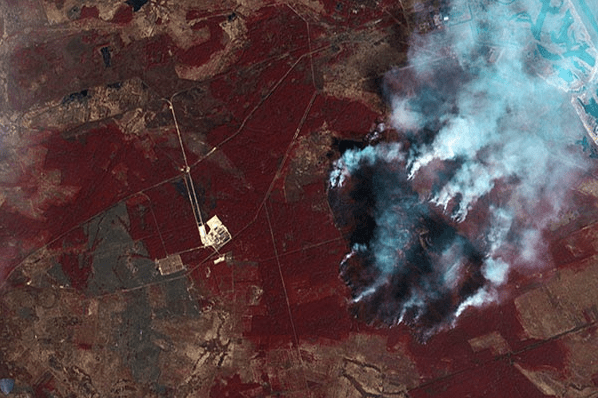
Unfortunately, fires are quite frequent and demolishing in this revived natural reserve. In 2015 and in 2020 the big fires burned down half of the radioactive Red Forest in Сhernobyl (reports https://en.wikipedia.org/wiki/Red_Forest). In the center of the Chernobyl Red Forest fire there was an increased level of radiation. At the same time the State Emergency Service of Ukraine reported that in Kiev and area it did not exceed the norm. A number of deserted and occupied villages and the territory of Red Forest of Chernobyl burned down. The animals were forced to cross the river Uzh to survive, but, having returned later, they found their forage (grass and other vegetation) burned to ashes. The main locations were not affected. The city of Pripyat evaded the fire which passed on its border.
Chernobyl Red Forest radiation levels
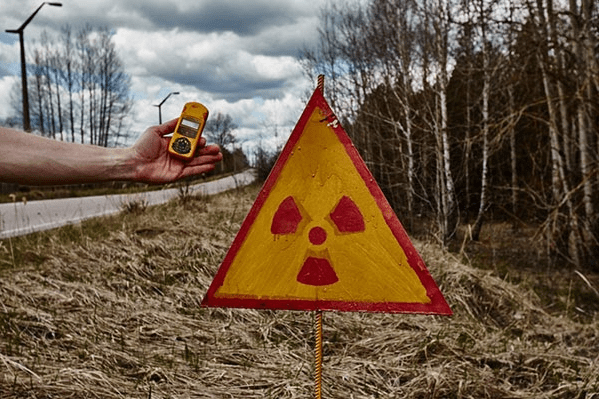
Until now, there are places in the Zone with significantly increased and even deadly radiation. Prolonged, unprotected stay in such places can lead to serious radiation damage to the body and even possibly to radiation sickness. However, now, due to efforts to clean up the Zone and with the passage of time (radiation decreases over time due to natural decay), the increased radiation levels are found only in the immediate vicinity of the exploded nuclear power plant, mainly in the wake of the most powerful western and northern emissions from the reactor and in some areas. The levels that could lead to acute radiation sickness remained only inside the Chernobyl Sarcophagus, a huge Shelter Object that stored a turned-up reactor behind its thick reinforced concrete walls. Only professionals can stay in such places when performing the necessary operations.
The average values in the Zone range from 0.3 microsieverts per hour away from the NPP to 2.5 microsieverts nearby. The radiation conditions of the exclusion zone are quite diverse and change (decrease) depending on the distance to the emission source. The average human radiation dose per year ranges from 2.4 millisieverts to 3 mSv. Today in Chernobyl, the average radiation background is about 0.29 μSv. In some places near the Chernobyl nuclear power plant, the number reaches 2.79 μSv. The total dose of external radiation that can be received during 10 hours of stay in the zone is several times less than during the transatlantic flight (2-3 hours on the plane).
Some places in the 10-kilometer exclusion zone still remain dangerous, so you can go to Chernobyl only with qualified specialists. During all our tours the dosimetry control is performed several times. The area is a dangerous place and not intended for strolling and are restricted for instance the “machine cemetery” of Rossokha village. Therefore, a visitor is allowed to move in the Zone only within the established route and only with a guide. In order not to become exposed to high levels of radiation, it is advisable to visit the Chernobyl zone as a member of a touristic group.
Chernobyl Red forest today
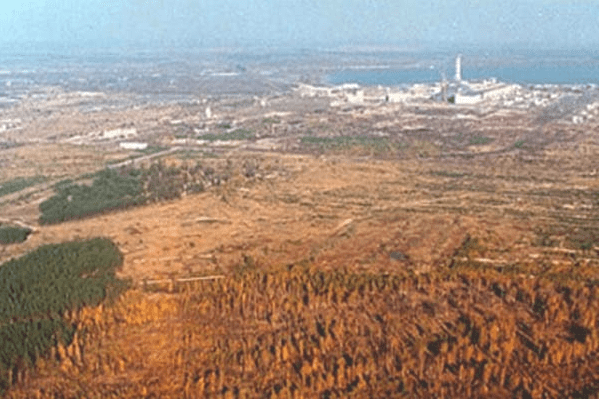
Chernobyl Red Forest location is about 10 km² of forest adjacent to the Chernobyl nuclear power plant, mainly in north and north-west direction, as you can see on the map, which accounted for the largest share of radioactive dust emissions during the 1986 reactor explosion.
Other diaries
12.10.2019 22:47
In the exclusion zone of the Chernobyl nuclear power plant, a robot dog Boston Dynamics SPOT was tested
In the exclusion zone of the Chernobyl nuclear power plant, tests of the SPOT robot, created by...More
12.10.2019 22:47
Facts about Chernobyl Radiation
Radiation is something that surrounds us every day. It can be both harmful and useful for us....More
12.10.2019 22:47
When will it be possible to live in Chernobyl?
The head of the Ministry of Natural Resources also said what work should soon be carried out near...More
12.10.2019 22:47
The most unique object is the Chernobyl exclusion zone
The exclusion zone is really another worldThe abandoned village of Zalesye
The abandoned...
More



